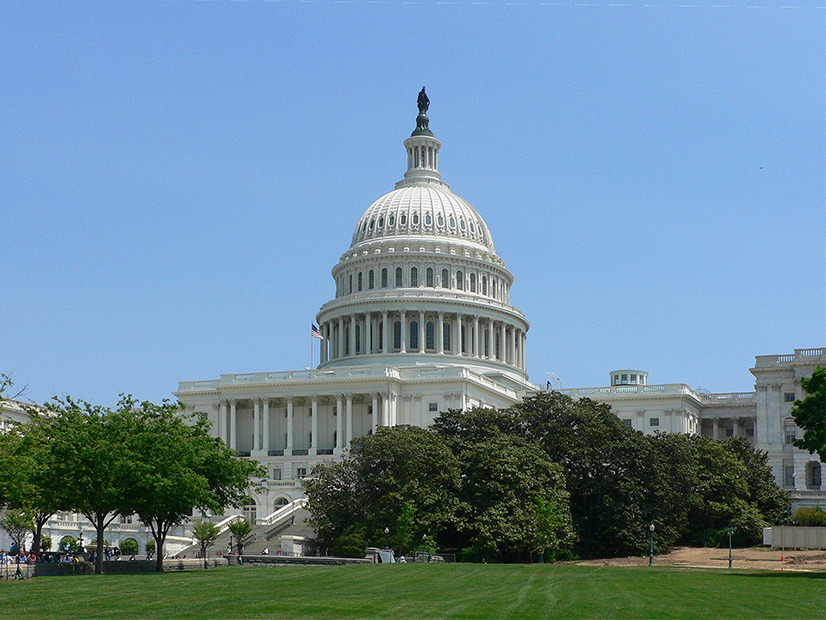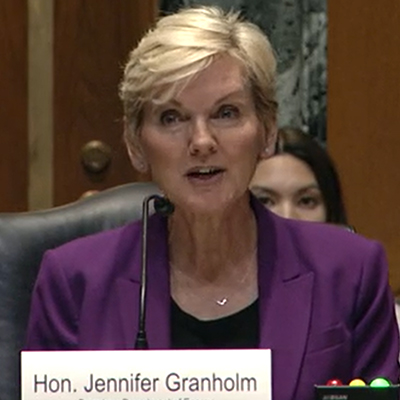
Sen. Jeanne Shaheen (D-N.H.) wants the Department of Energy to consider putting climate controls in all the rooms on Capitol Hill and explore the use of energy-saving performance contracts for federal buildings.
“It’s ridiculous that we can’t control the temperature in the rooms in this building,” Shaheen told Energy Secretary Jennifer Granholm during a Senate Appropriations Subcommittee on Energy and Water Development hearing Wednesday on DOE’s 2022 budget. “I would urge you to look at energy-savings performance contracts,” which Shaheen said cut heating bills and emissions for New Hampshire’s state buildings when she was governor.

But according to Joanne Lowry, strategic director of the department’s Federal Energy Management Program, performance-based contracting is a standard practice for its efforts to make federal government buildings more energy efficient. Under such contracts, building upgrades are paid for by actual energy savings.
Speaking during a Wednesday webinar on the 2022 budget for DOE’s Office of Energy Efficiency and Renewable Energy (EERE), Lowry said it provides a “significant bump-up” for program funding that will “continue to leverage that [performance-based] mechanism and explore other pathways to get money out.”
That bump-up is, in fact, a 10-fold increase from $40 million in 2021 to $438 million in 2022, according to figures presented during the webinar.
The two sessions — less than an hour apart — underlined the stark contrast between the politics of energy funding in Congress, and the actual programs that the budget makes possible and their potential impact.
Wednesday’s Capitol Hill hearing was Granholm’s fourth on the $46.2 billion budget request for 2022, and Republicans on the subcommittee continued to hammer away at President Biden’s infrastructure plan as an attack on the fossil fuel industry and jobs. Even if the U.S. can zero out its emissions, any impact on climate change would be nullified by countries such as China and India that continue to build coal plants, said Sen. John Kennedy (R-La.), the subcommittee’s ranking member.
“The administration’s hostility toward fossil fuels [is] more an emotional reaction than a rational reaction,” he said. “A lot of members of the administration … don’t see climate as a discrete scientific problem; they see it as a religion. They see it as a vehicle through which they can remake American society.”
Granholm stood her ground, noting that the budget and Biden’s American Jobs Plan both include funding for research, development and deployment of a range of clean technologies, from nuclear and green hydrogen to carbon capture and sequestration — all of which Kennedy and other Republicans said they favor.
“I want you to understand that we are there with you on that,” she told Kennedy.
As at a recent budget hearing before the Senate Energy and Natural Resources Committee, these low- or no-carbon technologies seemed to provide some common ground for Democrats and Republicans. (See Granholm Pitches DOE Budget to Senate Energy Committee.)
But some Democrats on the subcommittee also argued that specific line items should be increased. Pointing to the ongoing impacts of climate change in California, subcommittee Chair Dianne Feinstein (D-Calif.) wanted to raise the budget for DOE’s Office of Science to promote research on advanced computing, artificial intelligence and machine learning. Shaheen also pushed for more money for efficiency programs at the department’s Building Technologies Office, where, she said, “we know there are substantial energy savings being left on the table.”
Granholm used such comments to pitch the American Jobs Plan. For example, on building efficiency, she said passage of the fully funded plan “would allow us to push this much further, providing incentives to states to really up their game on building codes and allowing us to up our game on advising and giving technical assistance that is necessary to all these local units of government to do the same.”
Manufacturing
The EERE webinar offered a more granular look at the budget and the increased funding Granholm and Biden are seeking for specific programs that could, perhaps, also draw bipartisan support. The total EERE budget request of $4.7 billion is a 65% jump from 2021, in order to “focus on investments to drastically reduce emissions in the near term, while investing in research to ensure American leadership and competitiveness in advanced clean energy technologies,” said Anna Garcia, deputy assistant secretary for energy efficiency.
Going for fast emission reductions, the requested energy-efficiency funding is almost double from 2021 — from $1.1 billion to almost $2.2 billion — and accounts for close to half of the EERE budget, according to figures presented during the webinar.
Garcia broke down those figures further in her review of the department’s Weatherization Assistance Program (WAP), which provides funds to improve energy efficiency for low- and moderate-income households. In addition to a 27% increase in the funding for the program, Garcia said, this year’s budget includes a new line item: $21 million for a Weatherization Readiness Fund.

“The purpose of this fund is to reduce deferrals of homes that can’t be weatherized due to structural, health and safety repairs that cannot be done under the current WAP rules,” she said. “We know that our WAP crews are generally some of the first people to enter these homes and notice these structural, health and safety repairs that may not be intrinsic to the installation of the conservation measures.”
The new fund would, she said, reduce the number of homes that are turned down for WAP improvements.
Mike McKittrick, acting director of the Advanced Manufacturing Office, said the requested 39% increase in his budget, from $396 million to $550 million, would focus on decarbonizing the industrial sector while at the same time “growing a strong, resilient U.S. manufacturing sector.”
Key strategies for industrial decarbonization include energy efficiency at the process level and across product life cycles, electrification and fuel switching — for example, from natural gas to hydrogen — and carbon capture, utilization and storage, he said. Demonstration projects to help decarbonize steel, chemicals and cement are also in the budget, along with building out domestic supply chains for sourcing and processing critical minerals needed for clean technologies, such as lithium for batteries.
A featured investment in the Advanced Manufacturing budget, he said, “is a new lab-industry consortium that will validate and de-risk technologies that are important for critical mineral supply chains and the industrial ecosystem.”
With continuing Republican opposition, how these line items will fare in Congress is uncertain. Kennedy was not overly concerned with the numbers in Biden’s budget. “Senators are like cats,” he said. “They do what they want. We’re in the process of putting together a budget, and I don’t think I’m going out on a limb by saying it will be different that the president’s submission.”


